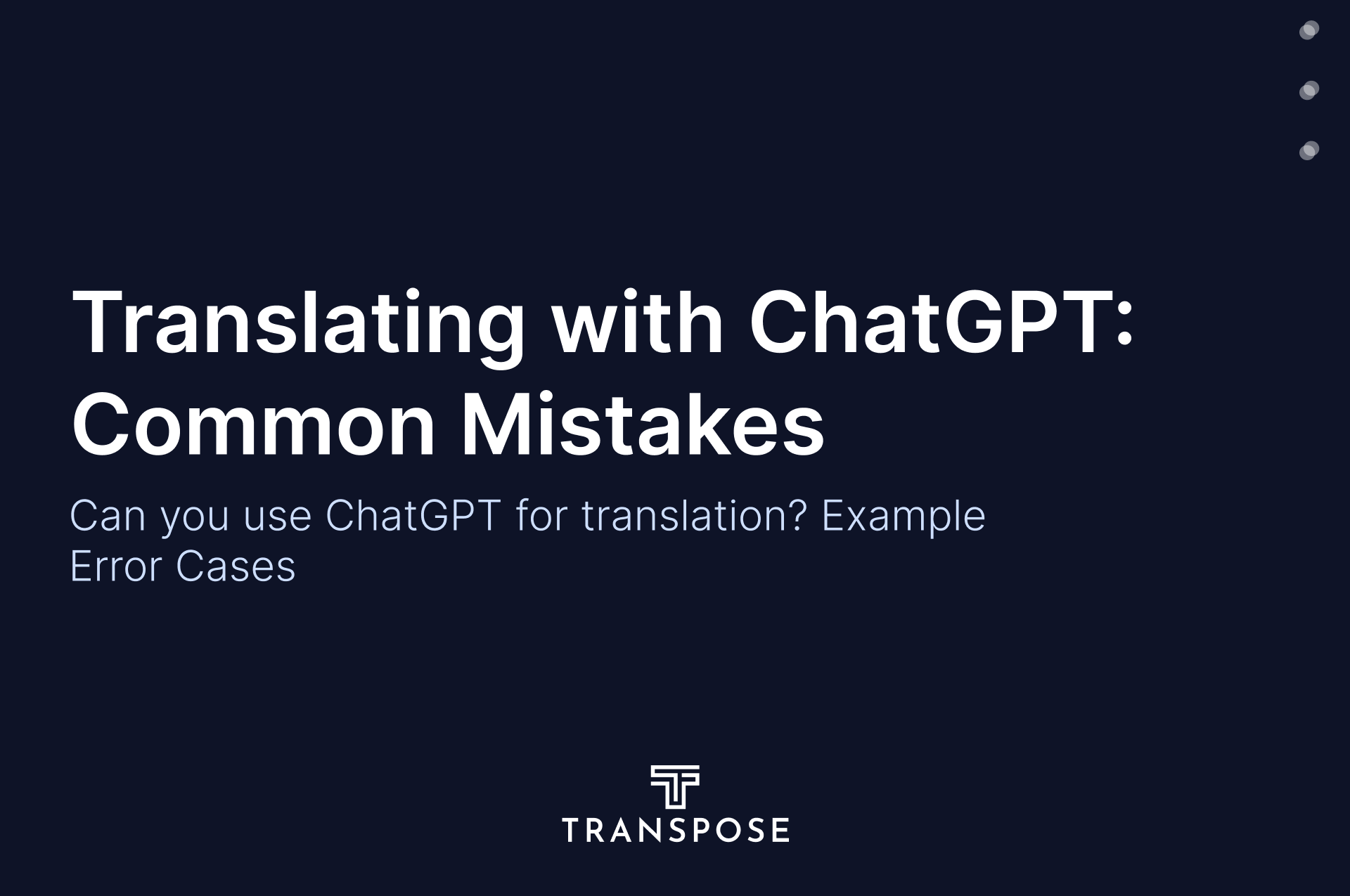ChatGPT has made it easy to do many text-based tasks, including translation. While it offers impressive capabilities for quick, basic translations, it also comes with significant limitations that businesses should understand before relying on it for professional communications.
In this article, we'll examine when ChatGPT translations fall short and provide real error examples.
What is ChatGPT's translation capability?
ChatGPT can handle basic conversational translations and simple content with reasonable accuracy. It performs best with straightforward sentences in common language pairs like English-Spanish or English-French.
Unlike dedicated translation tools, ChatGPT wasn't built primarily for translation, it approaches translation as part of its general language understanding capabilities. This means ChatGPT can handle conversational content reasonably well but may struggle with technical, legal, or highly specialized terminology.
Types of content ChatGPT can translate well
- Informal emails and messages
- Basic travel phrases
- Simple product descriptions
- General knowledge content
- Short social media posts
Content types where ChatGPT regularly fails
- Legal documents (contracts, patents, court filings)
- Medical documentation (patient records, clinical trials)
- Financial reports with specialized terminology
- Technical manuals with industry-specific terms
- Marketing content requiring cultural nuance
- Official documents requiring certification
Common errors ChatGPT makes during translation
Despite its capabilities, ChatGPT makes several predictable types of errors when translating content. Understanding these patterns helps businesses determine when AI translation might be suitable for their needs.
Here are the most common translation errors to watch for when using ChatGPT:
1. Cultural nuance and idiom mistranslation
ChatGPT frequently misses cultural contexts and idioms. It may translate expressions literally when they should be adapted for the target audience.
Marketing teams using ChatGPT to translate campaign materials risk producing content that falls flat or, worse, offends the target market. A marketing slogan that works perfectly in English might become nonsensical or inappropriate when literally translated to another language.
👉 You might also like to read: Cultural Sensitivity in Translation: What it is and why it Matters? (Examples)
2. Terminology inconsistency
ChatGPT often uses inconsistent terminology throughout longer documents. For example, it might translate a technical term correctly at first but use different terms for the same concept later in the document. Or, when translating a product manual, ChatGPT might use different terms for the same component throughout the document
This inconsistency creates confusion in technical documentation, where precision and consistency are crucial. Product managers relying on ChatGPT for user manual translations might find customers misunderstanding features due to terminology shifts.
3. Hallucinations and invented terms
One of the most concerning errors is when ChatGPT "hallucinates" translations. Sometimes it “invents” terms or phrases that don't exist in the target language.
For example, for a financial report translation, ChatGPT might insert numbers or details that never existed in the source document.
ChatGPT hallucinations happen particularly with technical or specialized content where the model lacks sufficient training data.
4. Grammar and syntax errors
ChatGPT can struggle with complex grammatical structures between languages with different syntax rules. It sometimes produces grammatically correct but semantically altered translations. The meaning shifts subtly but significantly.
When translating from English to Japanese, for instance, ChatGPT might produce sentences that follow English word order patterns, resulting in awkward or incorrect Japanese syntax.
5. Context misinterpretation
ChatGPT sometimes misses broader context, leading to incorrect word choices. When ChatGPT fails to understand the specific usage context, it can mistranslate words with multiple meanings.
When should businesses USE and NOT USE ChatGPT for translation?
Despite its limitations, ChatGPT can be useful for certain translation scenarios.
Acceptable use cases for translating with ChatGPT:
- Internal communications with non-critical content
- First-draft translations that will undergo human review
- Understanding the general meaning of incoming foreign language emails
- Creating rough translations of research materials
- Personal travel or casual communication needs
Avoid ChatGPT for translating the following content:
- Legal or binding documents, especially for documents that require sworn or certified translations
- Regulatory submissions
- Medical documents like instructions or patient information
- Financial disclosures or investment materials
- Technical specifications with safety implications
- Content requiring certification or official status
Which ChatGPT model is best for translation?
- GPT-3.5: Adequate for simple conversational content, high error rate for technical material
- GPT-4: Improved accuracy, better context understanding, still struggles with highly specialized content
- GPT-4o: Improved real-time translation capabilities, better cultural context awareness, limitations remain for legal and technical content
The newer models (GPT-4o, GPT-4.1, and GPT-4.5) have improved translation abilities compared to earlier versions, particularly for major language pairs. However, even these advanced models have inherent limitations that affect translation quality.
Tips for getting better translations from ChatGPT
If you must use ChatGPT for translation, these techniques can help improve results:
- Provide clear context about the document type and purpose
- Break longer texts into manageable chunks with sufficient context
- Specify the target audience and required tone
- Include any industry-specific terminology guidelines
- Ask for explanations of culturally specific terms
- Request alternative translations for ambiguous phrases
Conclusion: Making informed translation choices
ChatGPT and similar AI tools offer seemingly easy translation options for certain scenarios but come with significant limitations. For medical, marketing, business-critical and other specialized content, professional human translation remains essential.
Need to ensure your critical business documents are translated with precision and cultural awareness? Explore our ISO-certified translation services tailored to your industry-specific needs and compliance requirements.
